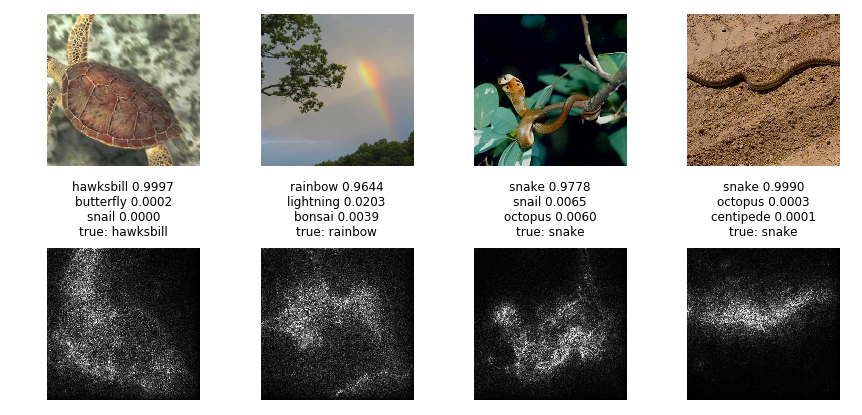| model | accuracy, % | top 5 accuracy, % | number of parameters |
|---|---|---|---|
| DenseNet-121 | 85 | 96 | 7,216,256 |
| DenseNet-121 with trained ternary quantization | 73 | 91 | ~7.2M 2-bit, ~79% zeros |
| DenseNet-121 with binary weights | 41 | 67 | ~7.2M 1-bit |
| DenseNet-201 | 87 | 97 | 18,584,704 |
| ResNet-18 | 81 | 94 | 11,307,840 |
| ResNet-18 with trained ternary quantization | 52 | 78 | ~11M 2-bit, ~86% zeros |
| ResNet-18 with stochastic depth | 70 | 89 | 11,307,840 |
| SqueezeNet v1.1 | 66 | 85 | 853,824 |
| SqueezeNet v1.1 with entropy regularization | 66 | 86 | 853,824 |
| Delegating classifiers | 77 | 93 | - |
Trained ternary quantization [2] is a method of reducing size of a neural network. It replaces all weights in a convolutional layer with +1, 0, -1 and two float scaling factors (one for +1 and one for -1).
SmoothGrad is a method of computing nice sensitivity maps. Sensitivity maps show which image pixels influence class predictions. They require to compute gradients with respect to an input image. Here are a few examples:

- I often use cosine annealing [6] of the learning rate. I believe that this reduces training time a lot.
- Python 3.5
- pytorch 0.2
- torchvision, Pillow
- numpy, pandas, sklearn, matplotlib, tqdm
[1] Regularizing Neural Networks by Penalizing Confident Output Distributions
[2] Trained Ternary Quantization
[3] Deep Networks with Stochastic Depth
[4] SmoothGrad: removing noise by adding noise
[5] XNOR-Net: ImageNet Classification Using Binary Convolutional Neural Networks